| |
| Students of 1900–1910 |
| Raymond McIntyre |
1894–1906 |
| Annie L. Ford |
1897–1909 |
| Cecil Kelly |
1900–08 |
| R.W. Webster |
1903–09 |
| Owen Merton |
1903 |
| Archibald F. Nicoll |
1905–07 |
| Eleanor Hughes (née Waymouth), |
1905–07 |
| David Low |
1905 |
| Katherine Beath |
1899 -1904 |
|
| 1900 |
Under George Herbert Elliot as Headmaster at this time, staff were recorded as 'S. Hurst Seager, ARIBA – Lecturer and Instructor in Architecture, Decorative Design, Wood Carving and Manual Training; A.W. Walsh – Drawing and Painting; Charles Kidson – Drawing, Geometry, Perspective, Modelling and Casting, and Stone Carving; H.L. Smith – Geometry, Perspective, Drawing and Wood Carving; H.F. Gibson – Drawing; and G.H. Bradley – Practical Painting and Decorating.' (1900 Jubilee Industrial Exhibition: Official Handbook) |
| 1902 |
Additional courses offered in 1902 include: Carving in wood, stone and marble; Repoussé work in copper, brass, etc; House painting, decoration, sign writing, gilding, embossing, graining and marbling; Architecture and building construction, design and drawing; Practical woodwork; Cabinetmaking; Special classes for teachers and others; Wood and metal work; Paper, carton, and canework; Wood-carving; Brushwork; Modelling in clay or plasticene; Chalk and charcoal work on blackboard and paper. Students are able to sit for City and Guilds of London Institute [technology] examinations. A technical lending and reference library was opened at the school as a resource for the trade students. |
| 1903 |
Charles Kidson is granted leave to travel to England and France where he gains experience in Arts & Crafts techniques including wood-carving, metal craft, modelling and plaster work, visiting Liberty's of London, and the Central School of Arts & Crafts, the South Kensington School, the Camden Town School of Art and his alma mater in Birmingham. In 1904, Kidson, with George Fraser, established a small art metalcraft business in Aylmer Street, Christchurch. In 1908 he sold a muffle furnace that he had been experimenting with for enamelling to the CCSA.
New courses offered this year are tradesmith's geometry and pattern drawing, carpentry and joinery.
|
| 1904 |
Katherine (Kate) Beath (1882–1979), who appears to have been New Zealand's first female architect, completes her studies at Canterbury College School of Art (1899–1904). After leaving CCSA, she begins training as an architect in the practice of Christchurch architect Samuel Hurst Seager, who also lectured in architecture and decorative design at the art school. Ann Calhoun, Simplicity and Splendour, p.50.)
Leonard Booth is appointed to staff (1903–33). Elizabeth Abbott (Kelly) is appointed to a part-time teaching position. |
| 1905 |
Robert Herdman-Smith, F.S.A.M., is appointed Director of the School (1905–17). He had arrived in NZ in 1902 and taught at the Wellington Technical College, and had previously been a silver medallist in design in London and Paris, a Queen's prizeman and South Kensington exhibitor and art master and lecturer at the Leeds School of Art and the Bath Municipal School of Art. With a background in the Arts and Crafts movement, Herdman-Smith quickly implements many changes to the School's programmes, principally a graduated system of courses of instruction to benefit both trades and professions, with a particular focus on graphics and design craft. He promotes design taught on practical lines with "considerable time [...] given to the study of plant-forms and their application to ornament". Plant-form studies are often based on plants and trees observed by the students in the nearby Christchurch Botanical Gardens. Ann Calhoun, Simplicity and Splendour, p.36.) |
| 1906 |
New Zealand International Exhibition of Arts and Industries is held in Christchurch. Students from the School decorate one of the exhibition halls. The exhibition provides an opportunity to measure Canterbury artists' development with contemporaries beyond New Zealand: designs evolved from original sketches of flowers are sent by the South Kensington School for display. The International Exhibition also provides a direct stimulus for the arts and crafts tendencies that Robert Herdman-Smith introduces at Canterbury College School of Art, and for the local Arts & Crafts Guild he founds that year with ex-students from the School.
Herdman-Smith states in the Prospectus that the object of the Guild is: 'to assist in cultivating among art and craft students a friendly and social spirit. To exhibit at meetings of the Guild, Sketches in any medium of a subject chosen by a committee, together with miscellaneous sketches and studies and craft workmanship, such as embroidery, lace, wood cutting, repousse, lithography, lead casting, stained glass, etc. etc. To encourage the reading of papers and essays, and the delivery of lectures on subjects relating to art and craft, to be followed by discussion, and times for music and the study of poetry.'
The School's courses are organised into four groups: Drawing and painting, design and crafts, modelling, architecture and building trades. The Prospectus notes: 'The courses of instruction give the students a thorough knowledge of drawing, painting, designing and modelling include special art training for designers, decorative artists, modellers, sculptors, plasterers, architects, cabinet makers, signwriters and decorators, carpenters and joiners, art craftsmen in wood, metal and stone; and for other professions depending upon a sound knowledge of drawing and for painters of landscape and the figure.'
Following his return from Europe in 1905, Sydney L. Thompson joins the staff as Life Master (1906–10). An Artists' Sketch Club is formed by Thompson and fellow artists including Cecil Kelly, Raymond McIntyre, Alfred Walsh, W. Menzies Gibb, Leonard Booth, Edwin Bartley, Kennaway Henderson, and Charles Bickerton. They meet regularly at Thompson's studio at 97 Cambridge Terrace, Christchurch. |
| 1907 |
Junior Free Day Students are admitted for the first time, under a Government scheme offering students two years' free education as juniors and a further three years as seniors. Between 1907 and 1945 an estimated 2000-3000 junior students would attend the School, including Evelyn Polson (later Page) in 1915.
Assisted by Raymond McIntyre, Cecil F. Kelly is taken on to teach elementary art to the first intake of Junior pupils. The following year, he also offers instruction in photographic retouching. Other appointments to the staff in 1907 include carver Frederick Gurnsey (1907–23), Art Needlework Tutor Mrs J.A. (Sidney) Mayne; Cecil F. Kelly (1907–1945) and R.W. Webster (1907–1921).
Frederick Gurnsey had trained at the Central School of Arts & Crafts in London and the School of Applied Art in Edinburgh, and also tutored at the Norwich School of Art. He taught carving, modelling, casting, enamelling and metalwork. (Ann Calhoun, Simplicity and Splendour, p.36.) In the wake of the 1906–07 exhibition, art and design students favoured art jewellery and enamelling, tutored by Gurnsey (and after 1917 by Ann Buckhurst).
Needlework lessons were initially taught by Miss Eva Mouldey who had organised the Junior School and improved the standard of work done in design and needlework until her resignation in 1926. (Janet Abbot, Daughters of Design) A graduate of the Royal School of Art Needlework, Mrs J.A. (Sidney) Mayne is appointed to teach embroidery, appliqué and needlework; the course name is later changed to Art Needlework. After the 1906–7 exhibition, and no doubt encouraged by the enthusiasm it engendered, art needlework became as popular as enamelling and art metalwork. (Ann Calhoun, Simplicity and Splendour, p.37.) |
| 1908 |
The School has nine instructors in pure and applied art by this time, and offers the following local Examinations and certificates: Elementary drawing certificate, Art Teacher's diploma, Architectural diploma, and Art Craftsman's diploma. Quantity surveying is offered as a new course. |
| 1909 |
Director of the School Robert Herdman Smith travels overseas to visit the leading English provincial art schools, as well as art schools in France, Germany, Belgium and Holland. He also purchases a number of works of art for the art school collection. Numbers of students enrolled at the school grow to crowded levels. |
|
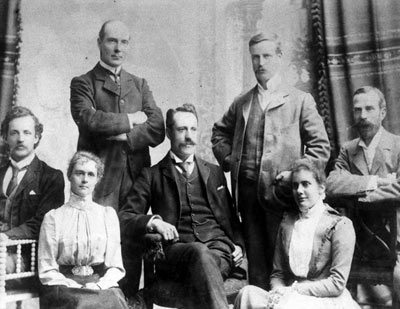
| The Staff at Canterbury College School of Art, 1900 |
From the left standing: Samuel Hurst Seager, Charles Kidson. From the left seated: George W. Bradley, Miss H.L. Smith, George Herbert Elliot (headmaster), Miss Helen F. Gibson, Alfred Walsh.
"The years between 1900 and 1949 were largely dominated by two generations of Canterbury artists and witnessed the rise of Canterbury art to a place of pre-eminence, which set the scene for a new order in the visual arts [in New Zealand]. But this would also incite a shift in attitudes in the years that followed, thus diminishing the position that Canterbury art once held. In 1900 Canterbury art was still on the brink of change with the first generation of artists to emerge from Canterbury College School of Art beginning to find a place in the art community."
(Neil Roberts, A Concise History, p.38.) |
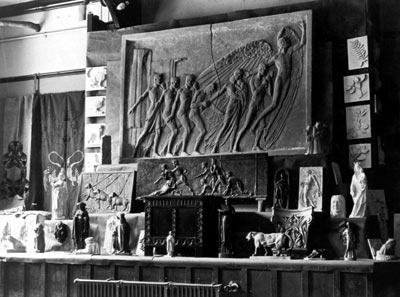
| Carving and Modelling Exhibition, Canterbury College School of Art, early 1900s |
In the School's 1906 syllabus the Principles of Ornament under the tutelage of Charles Kidson were said to be 'specially suited for Architects, Draughtsman, Designers, Plasterers, Modellers, Wood and Stones Carvers, Cabinet makers, and others engaged in Constructional work which allows Ornamentation. The course deals with the principles which govern all good ornament, such as repetition, unity, repose,stability, growth, spacing, proportion, etc.' |
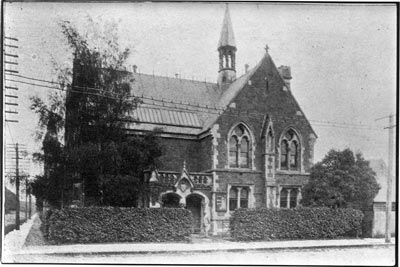
| Canterbury College School of Art, Hereford Street elevation, 1905 |
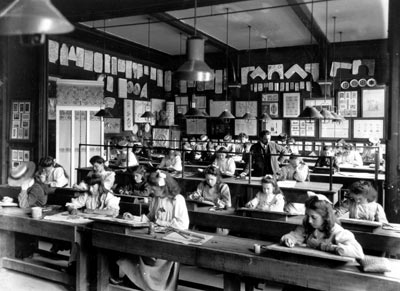
| Canterbury College School of Art – Design Room 1907 |
The School's syllabus for 1907 stated that students enrolled in the 'Design and Artistic Crafts Course' must provide themselves with 'drawing paper (best quality cartridge), drawing pins, rubber, 6 in. 60 [degree] and 6 in. 45 [degree] set squares, 12" scale, protractor, pencil, compass, dividers, and imperial T square.' Plane Geometry, Solid Geometry, Perspective, and Applied Geometry make up the course content. |
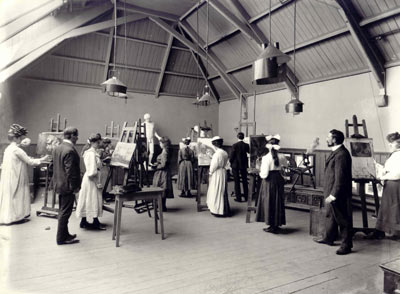
| Painting Class, Canterbury College School of Art, 1907 |
A painting class held in the Life Drawing room, now known as the Francis Shurrock Studio. One of the classical plaster models sent out from the South Kensington School of Art is visible at the far end of the room. |
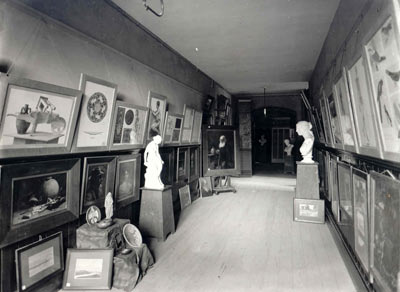
| Canterbury College School of Art – Exhibition 1907 |
The end-of-year exhibition was displayed in the upstairs corridor, which led to what is known today as the William Sutton Room. The corridor was re-designed around 1913. The syllabus from as early as 1882 stated that there will be 'public exhibitions of students' work at the end of each annual session: no work executed in the school can, therefore, be removed until after such examination. All drawings, when finished and approved of, must be delivered to the Master [in 1882, David Blair], who will be responsible for their safety, and return them to their owners at the end of the annual session.' |

| Canterbury College School of Art – Architectural Class 1907 |
In 1907 the Instructor for Architecture was H.L. White, a qualified architect. In addition to drawing and building construction, the course outline for the year included the following subject areas: 'Influence of constructive conditions on development of the various styles of Architectural; influence of social habits, of people of the various ages, and the available labour and materials. Studies in mass and detail of good specimens, to be drawn in both orthographic and perspective projection by students. Greek and Roman orders, with all enrichments. Essential differences between trabeated and arched architecture. Growth of European styles. British Architecture, twelfth century to renaissance, with descriptions of noted buildings.' |
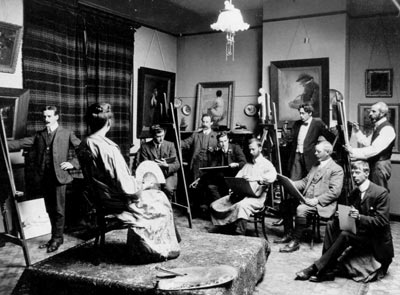
| The Artists' Sketch Club, 1908 |
Group of men painting a woman with a fan. L-R: Cecil Kelly. L. H. Booth,E. Bartley, A. K. Henderson, Sydney Lough Thompson (showing a 'stylish technique'), Raymond McIntyre, W. Menzies Gibb, Alfred Wilson Walsh, Charles Bickerton. A version of the Sketch Club was still operating atthe School of Fine Arts in the mid-1990s, as a social club for the artstudents. |

| Sketch Class Outdoors, c.1908–1912 |
An outdoor sketching class on the Avon riverbank, near the Helmores Lane Bridge, Hagley Park. The students would have walked across the Park from the School of Art, carrying lightweight portable easels. |
|









